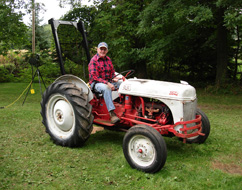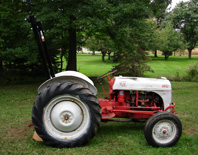Cost-effective Rollover Protective Structures (CROPS)

Completed CROPS Installation
The safety of wheeled agricultural tractors has increased significantly over the past 60 years. NIOSH recommends using newer tractors with safety features that include a rollover protective structure (ROPS), power take-off (PTO) guards, and manufacturer specific operational features that make newer tractors safer.
The best-known way to prevent overturn fatalities is the combination of a ROPS and seat belt use.1 Therefore, to maximize the tractor operator’s safety, NIOSH recommends that any tractor in use be equipped with a ROPS and a seat belt.
NIOSH recognizes that tractors without ROPS are still in use, often because ROPS are not commercially available for older tractor models. To fill this worker safety void, NIOSH engineers developed cost-effective rollover protective structures (CROPS) that can be built onto a tractor after market. If the older tractor does not have a ROPS and cannot be equipped with a ROPS or CROPS, then NIOSH recommends retiring it from service.
In addition to having a ROPS (or CROPS) on the tractor, the operator should always wear a seat belt for maximum protection in the event of a tractor rollover.
Tractor-related Overturn Fatalities
The available data show that tractor overturns continue to occur. Between 2011-2018, 971 tractor-related fatalities occurred in agricultural production.2 These types of fatalities could be rollovers, entanglements, or falls. Previous analyses have revealed that 45% of “tractor-related fatalities” in the US are due to tractor overturns.3 In Indiana, approximately 39% of all documented agricultural fatalities in 2015 involved an overturned tractor.4 In Ohio, tractor overturns accounted for 54% of all farm deaths during the period 2007-2016.5
Tractors without ROPS
Available data suggest that many tractors without ROPS are still in use. In 2011, the most recent year for which data were available, 59% of tractors in use were equipped with ROPS – meaning that 41% did not have ROPS.6 This was nearly the same as data from 5 years earlier,6 suggesting that growth of ROPS coverage seen in previous years had slowed.7 The continued use of older tractors without ROPS increases the risk for deaths and injuries in the event of a tractor overturn.
CROPS Designs
In 2008, NIOSH designed and tested CROPS for four tractor models: (1) Ford 8N, (2) Ford 3000, (3) Ford 4000, and (4) Massey Ferguson 135 in accordance with the same Society of Automobile Engineers (SAE) industry standard performance test SAE J2194 used for ROPS at that time.8 NIOSH researchers selected these four tractors for CROPS designs because they were in the top ten most popular and active older tractors based on a published analysis in 1998,9 and ROPS were not widely available for the selected models.
The NIOSH CROPS designs are available to be used either by
- an individual to build a NIOSH CROPS for their privately owned tractor
- a company to build and sell a NIOSH CROPS.
Certain parts must be manufactured by a facility that can bend 0.5-inch-thick plate steel (A572-Grade 50). Other parts can be manufactured using a band saw and a drill press. All welded parts must be welded by a professional welder using the appropriate welding procedures for a minimum temperature of -22°F (-30°C) as stated in the SAE J2194 standard. This is required regardless of temperature ranges in the end user’s local area.
Performance Testing of NIOSH CROPS Designs
NIOSH developed several designs through multiple iterations and tested them against the requirements of J2194 which was the accepted industry standard in 2008. NIOSH tested the tractor reference mass for these designs, and they exceeded the SAE J2194 standard by 25-32%. For example, the Ford 3000 has a suggested reference mass of 5300lbs (2404 kg); the tested reference mass was 7000lbs (3175 kg), which is 32% more than the suggested reference mass.
The Ford 3000 and 4000 model tractors’ axle housings were designed to support the installation of a ROPS by the manufacturer. The Ford 8N passed an axle strength test with a factor safety of two when evaluated by an external research study.10,11 The Massey Ferguson 135 axle is very similar to the Ford 8N axle and is considered to be of equal strength.
In 2016 a new industry testing standard, International Organization for Standardization (ISO) 570012, replaced SAE J2194. The NIOSH CROPS have not been tested for compliance to the current ISO 5700 testing standard.
Disclaimers
Users must build and install the CROPS per the NIOSH specifications and must not make any changes. Any deviation from the published designs or the installation of a CROPS will result in the CROPS not complying with SAE J2194. In the event of a rollover, the operators will not be provided with the level of protection established by SAE J2194.
The original equipment manufacturers (OEM) of the tractors were not involved in NIOSH development, design or testing of the CROPS project. NIOSH is providing its CROPS designs and installation instructions to the public pursuant to its mission to protect worker safety and is not offering a guarantee of any kind. Any user of the designs and installation instructions agrees to indemnify and hold harmless the United States government from any claims, costs, damages or losses that may arise from or through use of the designs and installation instructions. It is further agreed that the user will not by its action bring the United States government into any lawsuit involving the designs or installation instructions.
Proof of Concept


The NIOSH CROPS project conducted an outreach “proof of concept” effort to collect data from a sample of participants on the ease of installation and acceptance of the CROPS designs. The outreach efforts included installing the NIOSH CROPS in the states of New York, Virginia, Vermont, Pennsylvania, California, and West Virginia. The following groups facilitated installations:13,14
- in New York, the New York Center for Agricultural Medicine and Health (NYCAMH) at the NIOSH Northeast Center for Agricultural and Occupational Health (NEC) located in Cooperstown, NY
- in Vermont, NYCAMH/NEC through a partnership with the University of Vermont Extension
- in Virginia, the Virginia Farm Bureau
- in Pennsylvania, a partnership with the Pennsylvania State University
- in California, the University of California, Davis
- in West Virginia, NIOSH.
A total of 82 CROPS were installed in six states through this outreach effort. (View the 2012 Field Installation Pictures [PDF – 2 MB])
82 CROPS installed as of December 19, 2012
| Ford 8N | Ford 3000 | Ford 4000 | Massey Ferguson 135 | |
|---|---|---|---|---|
| New York |
20
|
4
|
7
|
6
|
| Pennsylvania |
5
|
2
|
||
| Vermont |
7
|
2
|
||
| Virginia |
2
|
15
|
4
|
5
|
| California |
1
|
1
|
||
| West Virginia |
1
|
CROPS Installation Information
Ford 8N
CROPS Installation Information: Ford 8N CROPS
| CROPS | |||||
|---|---|---|---|---|---|
| Testing Information [PDF-6 MB] Updated 2021 |
Technical Drawings [PDF-504 KB] |
Installation Steps [PDF-1,711 KB] Revised 2016 |
Installation Video [wmv-1,857 KB] No Audio |
Field Installation Pictures 2010/2011 [PDF-1,536 KB] |
Crossover Models [PDF-128 KB] |
CROPS Installation Information: Ford 8N Seat Belt
| Seat Belt | ||||
|---|---|---|---|---|
| Testing Information [PDF-377 KB] |
Technical Drawings [PDF-256 KB] |
Installation Steps [PDF-653 KB] Revised 2016 |
Seat Belt Forward Test Video [wmv-433 KB] No Audio |
Seat Belt Rear Test [wmv-281 KB] No Audio |
Ford 3000
CROPS Installation Information: Ford 3000
| CROPS | |||||
|---|---|---|---|---|---|
| Testing Information [PDF-4 MB] Updated 2021 |
Technical Drawings [PDF-464 KB] |
Installation Steps [PDF-1,040 KB] |
Installation Video [wmv-1,522 KB] No Audio |
Field Installation Pictures 2010/2011 [PDF-870 KB] |
Crossover Models |
Ford 4000
CROPS Installation Information: Ford 4000
| CROPS | |||||
|---|---|---|---|---|---|
| Testing Information [PDF-5 MB] Updated 2021 |
Technical Drawings [PDF-512 KB] |
Installation Steps [PDF-1,248 KB] |
Installation Video [wmv-1,889 KB] No Audio |
Field Installation Pictures 2010/2011 [PDF-1,148 KB] |
Crossover Models [PDF-130 KB] |
Massey Ferguson 135
CROPS Installation Information: Massey Ferguson 135
| CROPS | |||||
|---|---|---|---|---|---|
| Testing Information [PDF-5 MB] Updated 2021 |
Technical Drawings [PDF-498 KB] |
Installation Steps [PDF-1,909 KB] Revised 2016 |
Installation Video [wmv-1,852 KB] No Audio |
Field Installation Pictures 2010/2011 [PDF-951 KB] |
Crossover Models [PDF-131 KB] |
References
- Zwerling, C. et al. 1997. Use of Rollover Protective Structures-Iowa, Kentucky, New York, and Ohio, 1992-1997. MMWR, 842-845.
- U.S. Department of Labor, Bureau of Labor Statistics (BLS) (2018). Workplace Injuries Database – Census of Fatal Occupational Injuries public files.
- Murphy, Dennis J., Myers, John, McKenzie Jr., E. A., Cavaletto, Richard, May, John, Sorensen, Julie (2010). Tractors and Rollover Protection in the United States, Journal of Agromedicine, 15:3, 249-263.
- Cheng, Yuan-Hsin Cheng, Field, Bill (2016). 2015 Indiana Farm Fatality Summary With Historical Overview, Purdue University Agricultural Safety and Health Program.
- Jepson, Dee (2018). Ohio farm safety stats: Setting a goal for zero fatalities. Ohio’s Country Journal. September 14, 2018. The Ohio State University Department of Food, Agricultural and Biological Engineering.
- NIOSH Farm Safety Survey, Table FS-4, National Estimates of agricultural machinery on US farms.
- Loringer-KA; Myers-JR (2008). Tracking the prevalence of rollover protective structures on U.S. farm tractors: 1993, 2001, and 2004, J Saf Res Oct; 39(5):509-517.
- SAE J2194 Society of Automotive Engineers. (2008). SAE J2194 AUG2002. Roll-Over Protective Structures (ROPS) for wheeled agricultural tractors.
- Myers, JR; Snyder, KA; Hard, DL; Casini, VJ; Cianfrocco, R; Fields, J; Morton, L (1998). Statistics and Epidemiology of Tractor Fatalities—A Historical Perspective, Journal of Agricultural Safety and Health 4(2): 95-108.
- Li, Zhifeng; Ayers, PD (2008). Strength Test for Pre-ROPS Tractor Axle Housings, Journal of Agromedicine Vol. 4, No. 3/4, pp. 303-307.
- Li, Zhifeng (1997). Strength analysis for pre-ROPS tractor axle housings; Master of Science Thesis; Colorado State University.
- ISO 5700:2013. Tractors for agriculture and forestry — Roll-Over Protective structures — Static test method and acceptance conditions, International Organization for Standardization.
- Hard, DL, McKenzie, Jr, EA, Cantis, DM, May, J, Sorenson, J, Bayes, B, Madden, E, Wyckoff, S, Stone, B, Maass (2015). A Demonstration Project in New York and Virginia: Retrofitting Cost-Effective Roll-over Protective Structures (CROPS) on Tractors, 2015 J Agric Saf, vol 21 pages 173-185.
- Hard, DL, McKenzie, Jr, EA, Cantis, DM, May, J, Sorenson, J, Bayes, B, Madden, E, Stone, B, Maass, J (2016). The NIOSH CROPS Demonstration Project: A Study in New York and Virginia with an Emphasis on Youth, J Agric Saf, vol 22 pages 173-186.
